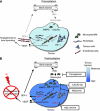Targeting SDF-1/CXCR4 to inhibit tumour vasculature for treatment of glioblastomas
- PMID: 21587260
- PMCID: PMC3111201
- DOI: 10.1038/bjc.2011.169
Targeting SDF-1/CXCR4 to inhibit tumour vasculature for treatment of glioblastomas
Abstract
Local recurrence of glioblastomas is a major cause of patient mortality after definitive treatment. This review discusses the roles of the chemokine stromal cell-derived factor-1 and its receptor CXC chemokine receptor 4 (CXCR4) in affecting the sensitivity of glioblastomas to irradiation. Blocking these molecules prevents or delays tumour recurrence after irradiation by inhibiting the recruitment of CD11b+ monocytes/macrophages that participate in revascularising the tumour. We review the literature pertaining to the mechanism by which revascularisation occurs following tumour irradiation using experimental models. Areas of interest and debate in the literature include the process by which endothelial cells die after irradiation and the identity/origin of the cells that reconstitute the tumour blood vessels after injury. Understanding the processes that mediate tumour revascularisation will guide the improvement of clinical strategies for preventing recurrence of glioblastoma after irradiation.
Figures

Similar articles
-
Inhibition of vasculogenesis, but not angiogenesis, prevents the recurrence of glioblastoma after irradiation in mice.J Clin Invest. 2010 Mar;120(3):694-705. doi: 10.1172/JCI40283. Epub 2010 Feb 22. J Clin Invest. 2010. PMID: 20179352 Free PMC article.
-
Blockade of SDF-1 after irradiation inhibits tumor recurrences of autochthonous brain tumors in rats.Neuro Oncol. 2014 Jan;16(1):21-8. doi: 10.1093/neuonc/not149. Epub 2013 Dec 10. Neuro Oncol. 2014. PMID: 24335554 Free PMC article.
-
Vasculogenesis: a crucial player in the resistance of solid tumours to radiotherapy.Br J Radiol. 2014 Mar;87(1035):20130686. doi: 10.1259/bjr.20130686. Br J Radiol. 2014. PMID: 24338942 Free PMC article. Review.
-
Recurrence of glioblastoma after radio-chemotherapy is associated with an angiogenic switch to the CXCL12-CXCR4 pathway.Oncotarget. 2015 May 10;6(13):11664-75. doi: 10.18632/oncotarget.3256. Oncotarget. 2015. PMID: 25860928 Free PMC article.
-
The CXCR4/SDF-1 chemokine axis: a potential therapeutic target for bone metastases?Curr Pharm Des. 2010;16(11):1284-90. doi: 10.2174/138161210791034012. Curr Pharm Des. 2010. PMID: 20166978 Review.
Cited by
-
Local CXCR4 Upregulation in the Injured Arterial Wall Contributes to Intimal Hyperplasia.Stem Cells. 2016 Nov;34(11):2744-2757. doi: 10.1002/stem.2442. Epub 2016 Jul 17. Stem Cells. 2016. PMID: 27340942 Free PMC article.
-
Glioma Stem Cells and Their Microenvironments: Providers of Challenging Therapeutic Targets.Stem Cells Int. 2016;2016:5728438. doi: 10.1155/2016/5728438. Epub 2016 Feb 10. Stem Cells Int. 2016. PMID: 26977157 Free PMC article. Review.
-
Targeting Refractory Mantle Cell Lymphoma for Imaging and Therapy Using C-X-C Chemokine Receptor Type 4 Radioligands.Clin Cancer Res. 2022 Apr 14;28(8):1628-1639. doi: 10.1158/1078-0432.CCR-21-3284. Clin Cancer Res. 2022. PMID: 35078860 Free PMC article.
-
MMP-2 suppression abrogates irradiation-induced microtubule formation in endothelial cells by inhibiting αvβ3-mediated SDF-1/CXCR4 signaling.Int J Oncol. 2013 Apr;42(4):1279-88. doi: 10.3892/ijo.2013.1806. Epub 2013 Feb 4. Int J Oncol. 2013. PMID: 23381805 Free PMC article.
-
In situ vaccination with laser interstitial thermal therapy augments immunotherapy in malignant gliomas.J Neurooncol. 2021 Jan;151(1):85-92. doi: 10.1007/s11060-020-03557-x. Epub 2020 Aug 5. J Neurooncol. 2021. PMID: 32757094 Review.
References
-
- Aghi M, Cohen KS, Klein RJ, Scadden DT, Chiocca EA (2006) Tumor stromal-derived factor-1 recruits vascular progenitors to mitotic neovasculature, where microenvironment influences their differentiated phenotypes. Cancer Res 66(18): 9054–9064 - PubMed
-
- Aicher A, Rentsch M, Sasaki K, Ellwart JW, Fandrich F, Siebert R, Cooke JP, Dimmeler S, Heeschen C (2007) Nonbone marrow-derived circulating progenitor cells contribute to postnatal neovascularization following tissue ischemia. Circ Res 100(4): 581–589 - PubMed
Publication types
MeSH terms
Substances
LinkOut - more resources
Full Text Sources
Other Literature Sources
Medical
Research Materials

